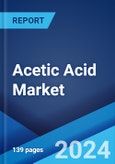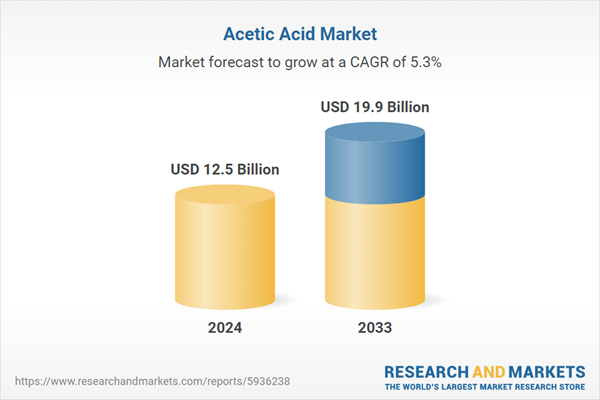The global acetic acid market size reached USD 12.5 Billion in 2024. Looking forward, the market is forecast to reach USD 19.9 Billion by 2033, exhibiting a growth rate (CAGR) of 5.3% during 2025-2033. Rapid product utilization as a feedstock for various chemicals, the rising popularity of lightweight and recyclable PET bottles, and the growing sales of vehicles across the globe represent some of the key factors driving the market.
Competitive analysis such as market structure, market share by key players, player positioning, top winning strategies, competitive dashboard, and company evaluation quadrant has been covered in the report. Also, detailed profiles of all major companies have been provided. The market structure is moderately fragmented by a handful of companies with the top companies accounting for a majority of the market share. The volume of new entrants is high in the acetic acid industry due to initial capital investment and low product differentiation.
This report provides an analysis of the key trends in each sub-segment of the global acetic acid market report, along with forecasts at the global and regional level from 2025-2033. The report has categorized the market based on application and end-use.
2. What is the expected growth rate of the global acetic acid market during 2025-2033?
3. What are the key factors driving the global acetic acid market?
4. What has been the impact of COVID-19 on the global acetic acid market?
5. What is the breakup of the global acetic acid market based on the application?
6. What is the breakup of the global cheese market based on the end-use?
7. What are the key regions in the global acetic acid market?
8. Who are the key players/companies in the global acetic acid market?
Several Technological Advancements Augmenting Market Growth
The advent of the cativa and acid optimization plus (AO-plus) process represents one of the major factors bolstering the market growth around the world. It delivers significant savings in variable costs and lower capital costs for the construction of new plants. It also offers increased capacity, enhanced production efficiency, reduced energy consumption by approximately 30%, and lower operating costs.Competitive analysis such as market structure, market share by key players, player positioning, top winning strategies, competitive dashboard, and company evaluation quadrant has been covered in the report. Also, detailed profiles of all major companies have been provided. The market structure is moderately fragmented by a handful of companies with the top companies accounting for a majority of the market share. The volume of new entrants is high in the acetic acid industry due to initial capital investment and low product differentiation.
What is Acetic Acid?
Acetic acid, also known as methane carboxylic acid and ethanoic acid, is a pungent-smelling liquid that has a sour taste. It can be produced by fermentation, oxidation of ethanol, or by chemical synthesis. It can also be manufactured by the breakdown of carbohydrates and fats, and it helps to maintain the acidity of the blood within a narrow range. It is characterized by a clear, colorless liquid, has a strong odor of vinegar and is corrosive to tissues and metals. It is a polar solvent and can dissolve many polar and nonpolar compounds. It can react with alcohols to form esters, with metals to form acetates, and with bases to form acetate salts. It is used as a solvent in the production of certain pharmaceutical products, such as vitamins, antibiotics, and other drugs. It is also utilized as a reagent in the synthesis of active pharmaceutical ingredients (APIs), such as acetylsalicylic acid (aspirin) and acetaminophen.COVID-19 Impact
The COVID-19 pandemic outbreak caused a significant impact on the acetic acid industry and imposed unprecedented challenges on numerous countries. The reduced demand for acetic acid was primarily due to the slowdown in industrial activities and the closure of many manufacturing plants. The pandemic severely affected industries, such as textiles, automotive, and construction, which are major consumers of acetic acid. This led to a significant reduction in the production and consumption of acetic acid. The impact of the pandemic on the acetic acid industry was also felt in terms of supply chain disruptions. The restrictions on transportation and logistics disrupted the supply of raw materials and the delivery of finished products, leading to a decrease in the production of acetic acid. The closure of borders and the decrease in international trade also had a significant impact on the industry. Despite the challenges faced by the industry, some companies were able to adapt to the changing market conditions. They diversified their product offerings and focused on the production of other chemicals that were in high demand during the pandemic, such as sanitizers and disinfectants.Acetic Acid Market Trends
The increasing use of acetic acid as a feedstock in the production of various chemicals, including vinyl acetate, acetic anhydride, and acetate esters, in confluence with significant growth in the chemical industry, represents one of the major factors strengthening the market growth around the world. Moreover, the rising utilization of acetic acid in the manufacturing of coatings, greases, polyesters, and sealants, which finds application in different industry verticals, such as electronics, automobiles, textiles, and packaging, is favoring the growth of the market. In addition, the growing usage of acetic acid in the preparation, storage, and preservation of processed food products is influencing the market positively. Apart from this, the increasing adoption of acetic acid for producing purified terephthalic acid (PTA) on account of the rising popularity of lightweight and recyclable polyethylene terephthalate (PET) bottles is contributing to the market growth. Furthermore, there is an increase in the adoption of acetic acid in the automotive industry for producing anti freeze and coolant fluids. This, coupled with the growing sales of luxury vehicles on account of rapid urbanization and inflating income levels is creating a positive outlook for the market. Besides this, the rising consumption of vinegar as it helps in promoting weight management, maintaining blood pressure, and regulating blood sugar and cholesterol levels, is catalyzing the demand for acetic acid in the manufacturing of vinegar. Additionally, leading manufacturers are investing in research and development (R&D) projects to minimize energy consumption, lower overall operating costs and ensure increased production efficiency.Market Segmentation
This report provides an analysis of the key trends in each sub-segment of the global acetic acid market report, along with forecasts at the global and regional level from 2025-2033. The report has categorized the market based on application and end-use.Application Insights
- VAM
- PTA
- Anhydride
- Ethyl Acetate
- Butyl Acetate
- Others
End-Use Insights
- Plastics and Polymers
- Food and Beverage
- Inks, Paints and Coatings
- Chemicals
- Pharmaceuticals
- Others
Regional Insights
- China
- North America
- Western/Eastern Europe
- North East Asia
- South East Asia
- Middle East & Africa
Competitive Landscape
The report has also provided a comprehensive analysis of the competitive landscape in the global acetic acid market. Some of the companies covered in the report include:- British Petroleum Plc
- Celanese Corporation
- Daicel Corporation
- Eastman Chemical Company
- GNFC Limited
- HELM AG
- LyondellBasell Industries N.V.
- Mitsubishi Chemical Corporation
- PetroChina
- SABIC
- Showa Denko K.K.
- Sinopec
- Svensk Etanolkemi AB (SEKAB)
- Wacker Chemie AG
The essential aspects of the global acetic acid market evaluated in the report include
- Market trends
- Major regions
- Impact of COVID-19
- Key application areas
- Major End-Use Industries
- Key manufacturers
- Price trends
- Raw material requirements
- Chemical reactions involved in the manufacturing process
- Major importers and exporters
- Value chain analysis
- Market trends for major feedstocks
- Price trends for major feedstocks
- Key regions for major feedstocks
- Key players for major feedstocks
Key Questions Answered in This Report
1. What was the size of the global acetic acid market in 2024?2. What is the expected growth rate of the global acetic acid market during 2025-2033?
3. What are the key factors driving the global acetic acid market?
4. What has been the impact of COVID-19 on the global acetic acid market?
5. What is the breakup of the global acetic acid market based on the application?
6. What is the breakup of the global cheese market based on the end-use?
7. What are the key regions in the global acetic acid market?
8. Who are the key players/companies in the global acetic acid market?
Table of Contents
1 Preface3 Executive Summary
2 Scope and Methodology
4 Introduction
5 Global Acetic Acid Industry
6 Market Breakup by Region
7 Market Breakup by Application
8 Market Breakup by End-Use
9 Competitive Landscape
10 Acetic Acid Manufacturing Process
11 Acetic Acid: Feedstock Analysis
List of Figures
List of Tables
Companies Mentioned
- British Petroleum Plc
- Celanese Corporation
- Daicel Corporation
- Eastman Chemical Company
- GNFC Limited
- HELM AG
- LyondellBasell Industries N.V.
- Mitsubishi Chemical Corporation
- PetroChina
- SABIC
- Showa Denko K.K.
- Sinopec
- Svensk Etanolkemi AB (SEKAB)
- Wacker Chemie AG
Methodology

LOADING...
Table Information
| Report Attribute | Details |
|---|---|
| No. of Pages | 145 |
| Published | February 2025 |
| Forecast Period | 2024 - 2033 |
| Estimated Market Value ( USD | $ 12.5 Billion |
| Forecasted Market Value ( USD | $ 19.9 Billion |
| Compound Annual Growth Rate | 5.3% |
| Regions Covered | Global |
| No. of Companies Mentioned | 14 |









